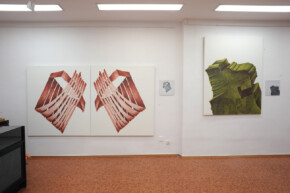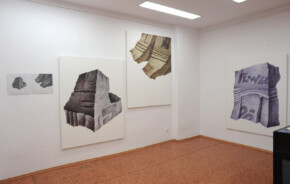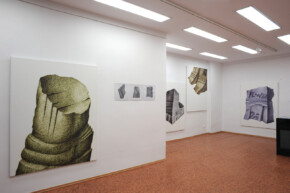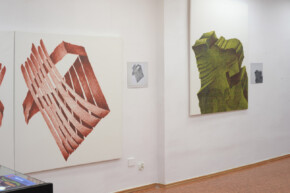Ryszard Wietecki was born in Bydgoszcz, on January 5th, 1940. Studied art at the Faculty of Fine Arts of Nicolaus Copernicus University in Toruń. In 1964, graduated under Prof. Stanisław Borysowski. In December of that year he became a member of the Association of Polish Artists. He paints, draws and does functional graphics. Has presented his works at several group exhibitions in Poland and abroad. In the years 1966-1976 he participated in the exhibitions of an informal art group with his friends ; Leon Romanow and Jerzy Gurda.
In 1970-1972, together with Leon Romanow, was active in the domain of conceptual art, founding the „Independent Non-Existent Gallery NO”. He printed and distributed all over the country the subsequent editions of the „non-existent gallery”; he also presented his objects at unconventional art meetings, such as „Dreamers Convention” ; Elbląg; „Status of a Work of Art ; Today” ; Katowice; „Cleaning of Art” ; Brama Gallery, Warsaw. At the „Light and Sound in Human Neighbourhood” ; 10 Gallery, Warsaw (1970), he presented „the object for listening to the silence enriched with a system of sounds coming from the outside”, created together with Leon Romanow. After 1972, together with Leon Romanow they made the decision to terminate their conceptual activities. In addition, he participated in numerous painting open-airs and post-open-air exhibitions (among others in Osieki). In 1995, he participated in the exhibition „1970s. ; Bydgoszcz Place of Art” in the Leon Wyczółkowski District Museum in Bydgoszcz, where for the first time he presented the full documentation of the „Independent Non-Existent Gallery NO”, as well as paintings and drawings from that period that opened the exhibition. His works are in several museums in the country, among others, in Bydgoszcz, Toruń, Grudziądz, Słupsk and Gdańsk, as well as at the Centre for Contemporary Art in Toruń and in private collections ; Poland, Germany, Austria, Denmark, Lithuania.
The painting work of Ryszard Wietecki, consistently developed since 1960s, is a cosmological story recorded in the language of signs. The mysterious objects are traces of some civilization, culture, of some unspecified presence. The word „some” in this case takes on special importance, because it is difficult to define the origin and time of these enigmatic objects. Almost instinctively, when communing with the painting by Ryszard Wietecki, one has the feeling of time being transfered to another dimension, as if the future and the past lost their fixed directions in our consciousness. We look at the traces of reality difficult to guess and classify. The clear, easy to read message of the images themselves assumes the impenetrability of the area of mystery. We are dealing here with a cosmic taboo, which raises the state of a peculiar dilemma and anxiety difficult to describe, because it was born as if outside the narrative to which we are accustomed. Creative and intriguing message forces us to „read” the content both from the images and our own thoughts. These cosmic phantasmagoria with a stigma of unspecified technique are like random letters from the universe. The artist as narrator of the unrecognised reality keeps self-restraint, leaving the viewers in the role of someone who on their own find or discovers content important for them. Are these signs from some mysterious world warnings, messages, or just a medium about an existence that’s hard for us to comprehend? There is no way to explain it. Creating one’s own system of signs and symbols has certainly the advantage of preserving the autonomy of interpretation, it does not impose literalism. The author opens up a variety of inspiring spaces for reflection, suggesting only a kind of consciousness or way of thinking that helps to approach the goal. With such an approach, it’s worth considering whether it is an archeology of a freely developed poetic experience or thorough documentation of the imagination of an artist that sees and describes the world in the final stage of civilisation? A quote from Godfrey Reggio* may be helpful here. Quoted statement has been chosen by the painter as the motto of his last exhibition:
…We live in the world of wild technology ; but we still like to think that we’re in control, while it rules over us already. It has become our new environment. Once we were limited by geography, we lived locally, and then there came culture, which is now lost in technology; Frankenstein we have created is becoming independent of us. We are witnessing a transition to a different era.
Jacek Soliński, Bydgoszcz 2011
*Godfrey Reggio was born in 1940 in New Orleans; American director and screenwriter, author of the Qatsi Trilogy. „Qatsi” in the language of the Native American Hopi people means „life”. Movies ; parts of the trilogy: „Koyaanisqatsi” („Life Out of Balance”), „Powaqqatsi” (Life in Transformation), „Nagoyqatsi” („Life as War”). The leitmotif of all the movies by Reggio is music by Philip Glass
curator of the exhibition: Elżbieta Kantorek
exhibition open from November 9 till December 8, 2012





